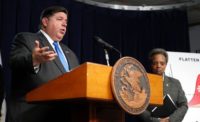Mayor Lori E. Lightfoot 's $3.7-billion, five-year capital spending plan was approved through the Chicago City Council's finance committee Nov. 18 by a 22-10 vote of aldermen. From decaying bridges to bumpy roads and an eroding Lake Michigan shoreline, repairing a decades-old backlog of Chicago’s aging infrastructure is the focus of the plan.
The 26-page capital plan is scheduled to be voted on by the full city council on Monday.
The plan outlines a program that would target $3.7 billion to make infrastructure investments in all of the city’s 77 communities, according to a statement released by the Mayor’s office. Lightfoot called the capital program "an ambitious campaign to invest in Chicago’s residents and businesses." However, the plan —the Lightfoot administration and its office of management and budget's first — is far leaner than the last capital improvement plan, submitted by then-Mayor Rahm Emanuel in 2018, before the pandemic and subsequent lockdowns affected city revenues such as sales and transportation taxes. That five-year plan, expected at the time to end in 2022, called for $8.7 billion in infrastructure spending.
Some parts of the plan include $216 million for aldermen to pursue infrastructure programs in each of their own wards, a controversial, political perk known as the aldermanic menu which allows them to address specific local infrastructure needs.
The plan calls for $230.5 million to fund 60 bridge repair and replacement projects and $24.4 million to fix underpasses and viaducts. About $250 million would pay for street resurfacing and $112 million would go to replace light poles and lighting.
In addition, $112 million would be set aside for sidewalk repairs, $49 million for bicycle lanes and dedicated bus routes, $112 million for sidewalk repairs, and $49 million for bicycle lanes and dedicated bus routes.
Green initiatives would increase the ability of streets and alleys to absorb storm water and reduce the pressure on sewers by increasing the number of green alleys the city constructs from 8 to 50 annually. The city also would spend an additional $3 million each year to plant new trees.
The city plans to fund the 2021 and 2022 construction through proceeds from General Obligation bonds, a total of $1.4 billion in new borrowing. A previously announced program to replace connections from residences to city sewers is not a part of the plan.
Chicago officials claim the plan will create 11,600 jobs, during the next five years. The city reports that the plan was developed based on needs-based condition assessments and data-driven processes.
One of aldermen who voted against the plan in the finance committee is Ald. Ray Lopez (15th Ward) said he believes it comes up short in many ways.
“What the mayor has proposed is neither comprehensive or inclusive,” he said. “To be perfectly honest, I have no idea how she’s prioritized or quantified the projects being listed in the communities.”
He said an overall strategy would better prioritize projects.
“If we were going to have a universal strategy, the first thing we’d do is scrap the aldermanic menu,” he said. “No longer would we need to inefficiently spend millions on projects here and there. We’d actually set a course for five years of improvements and knock out as many of the big ticket items as possible.”
Lopez also believes borrowing to fund the plan is financially perilous. Instead of borrowing, he said capital improvements should be funded by a dedicated tax, such as an increase in the gas tax.
“You’d have to look at when it’s economically feasible to have that kind of stable revenue source,” he said. “But borrowing is not a stable revenue source.”
Ald. Gilbert Villegas (36th Ward) supports the plan.
“Now more than ever, our residents are in need of good-paying, sustainable jobs to stay afloat and remain a part of the communities they call home," he said in a statement. “The five-year plan will not only satisfy this need, but it will also significantly enhance our residents' quality of life through infrastructure projects.”
The plan also places a priority on using minority, women-owned and locally owned businesses.
Here are some of the line items of the plan:
- Aldermanic Menu Program: $216 million over two years that includes increasing the yearly menu budget, per ward, from $1.32 million to $1.5 million.
- Bridges and Viaducts: $164.3 million to complete the funding for 23 bridge replacement projects, $66.2 million for 37 bridge repair projects, $16.9 million to rehabilitate 13 underpasses; and $7.5 million to begin the process of improving vertical clearance at 5 viaducts.
- Pavement Resurfacing: $250.4 million for residential and arterial street resurfacing based on the Pavement Condition Index and ADA Ramp needs. This also funds the reconstruction of 37 Works Progress Administration streets annually along with 100 new green alleys to improve drainage and sustainability; one green alley in each ward every year.
- Street Lighting: $112.3 million to replace 4,000 aging light poles, complete replacement of 300 blocks of lighting infrastructure, and strategic wiring stabilization repairs.
- Traffic Signals: $28.4 million to modernize the City’s historically underfunded traffic signal system.
- Sidewalks and Pedestrian Right-of-Way: $112.2 million for sidewalk repair (hazardous, vaulted, shared sidewalk programs, ADA ramps, curb and gutter, and alley aprons) to increase accessibility and public safety.
- Complete Streets: $49 million for improvements to bike lanes, priority bus routes, pavement markings and Vision Zero pedestrian safety projects. $104.2 million towards the funding of 24 streetscape projects including those in Invest South/West Corridors. $6 million for planting 12,000 trees.
- Waterways: $12.3 million for the reconstruction of 1 mile of lakeshore encompassing Morgan Shoal and the expansion of the Calumet River Dredging Facility to ensure clean waterways for commerce on the Calumet River.
- Facilities: $132.5 million for renovations and system upgrades to public facilities such as Department of Family and Supportive Service centers, Chicago Department of Public Health locations, Chicago Public libraries, dozens of non-public facing facilities. This budget also includes environmental remediation of city-owned land and demolition of hazardous buildings.
- Equipment: $162.1 million for the city’s fleet, equipment, and IT systems.





.jpg?height=200&t=1669066791&width=200)
Post a comment to this article
Report Abusive Comment